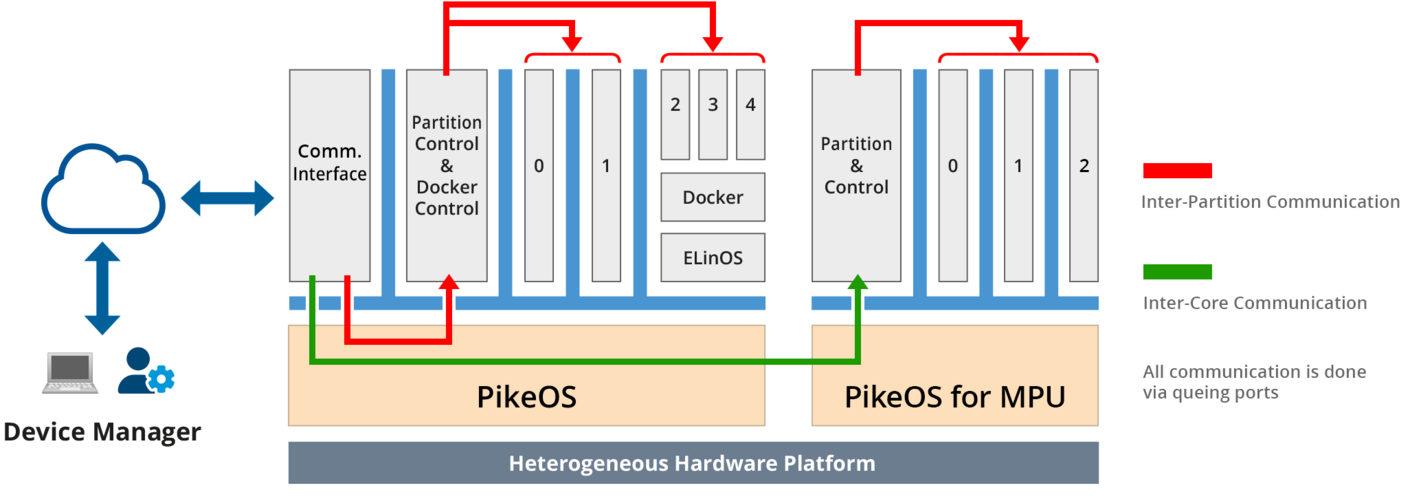Real-Time Data Processing
Enables rapid and reliable decision-making at the Edge
Integrated Security
End-to-end encryption and secure boot mechanisms
Remote Device Management
Centralized control and monitoring of Edge devices, ensuring seamless network operations
Scalable Architecture
Tailored for evolving a broad range of IoT ecosystems
Certified Safety and Security
Aligned with strict global standards for critical systems
AI Support
Integrate real-time analytics and machine learning for optimized operations and predictive insights
Device Manager
Orchestrating these layers, the Device Manager provides centralized control and remote management capabilities, ensuring integrity and synchronization across the platform.
Cloud Layer
The Cloud Layer serves as the centralized hub for data processing and storage, facilitating large-scale analytics and machine learning. It orchestrates communication, ensuring coherent operational strategies across the network.
Edge Layer
Powered by PikeOS, the Edge Layer enables immediate data processing and storage, facilitating real-time operational decisions and localized responses. The Secure Gateway ensures data integrity and swift, secure communications.
Device Layer
Interfacing with the physical world, the Device Layer collects data from sensors and executes actions through actuators, within the IoT framework.
Communication Interface
Positioned atop PikeOS, the communication interface serves as the initial gateway between the Edge platform and the Cloud. It validates commands before forwarding them.
Command Verification
Commands received by the communication interface undergo stringent verification to ensure authenticity before being processed further.
Inter-Partition Communication
Within PikeOS, the communication interface communicates with the "Partition Control & Docker Control" using inter-partition communication, facilitating seamless intra-core interaction.
Inter-Core Communication
All partitions on the same core, whether PikeOS or PikeOS for MPU, communicate via inter-core communication, ensuring clarity and accuracy in data exchange.
Bridging PikeOS and PikeOS for MPU
To relay commands to the "Partition Control" on PikeOS for MPU, the communication interface employs inter-core communication due to their placement on different cores, ensuring efficiency.
IoT Growth & Scalability
Our PikeOS Edge-to-Cloud platform enables seamless integration of an expanding array of smart devices, fostering IoT growth and connectivity. The adaptable architecture scales seamlessly to accommodate growth, ensuring continued performance and efficiency in various systems and applications
Certification-ready
The platform supports mixed criticality applications with robust Safety and Security features, ensuring compliance with certification standards in industries such as Avionics, Space, Railway, Automotive, or Industrial Automation
Security & Privacy
Localized data processing enhances Security and privacy, mitigating risks associated with centralized data storage
Data Sovereignty
Compliance with local data regulations ensures adherence to data sovereignty principles. These can be quickly reconfigured or updated to meet the new standards, fostering trust and compliance
Latency
Real-time response capabilities ensure swift decision-making, crucial in scenarios where latency is critical (such as sensor data processing, synchronizing machinery, robotics, or other automated systems)
Bandwidth
Efficient data transfer mechanisms optimize bandwidth usage, facilitating smoother communication between devices and networks
Operational Resilience
Independent functioning guarantees uninterrupted operations, vital for maintaining business continuity even in the event of faults
Customizability & Hybrid Deployments
Our solution can be tailored to various devices to empower our customers to meet specific requirements, enhancing flexibility and functionality. Flexible resource allocation allows for hybrid deployments, optimizing resource utilization across Edge and Cloud environments










